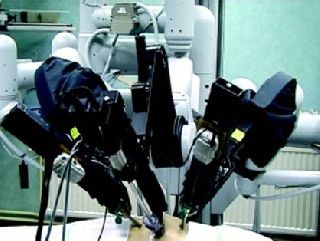Prostate cancer is one of the most common types of cancer in men, with an estimated 248,530 new cases diagnosed in the United States in 2021. Treatment options for prostate cancer include surgery, radiation therapy, and hormonal therapy, among others. Pelvic lymph node dissection (PLND) is a surgical procedure that is often performed as part of radical prostatectomy to remove the lymph nodes in the pelvic region. Robotic-assisted laparoscopic prostatectomy (RALP) is a minimally invasive surgical technique that utilizes a robotic system to perform the surgery. In this essay, we will examine the benefits and risks of PLND by RALP for the treatment of prostate cancer.
What is Robotic-assisted Laparoscopic Prostatectomy (RALP)? Robotic-assisted laparoscopic prostatectomy (RALP) is a minimally invasive surgical technique that utilizes a robotic system to perform the surgery. During the procedure, the surgeon makes several small incisions in the patient's abdomen and inserts a laparoscope, which is a thin, flexible tube with a camera and light on the end. The robotic system, which is controlled by the surgeon, uses small instruments to remove the prostate gland and any cancerous tissue.
What is Pelvic Lymph Node Dissection (PLND)? Pelvic lymph node dissection (PLND) is a surgical procedure that is often performed as part of radical prostatectomy to remove the lymph nodes in the pelvic region. The lymph nodes are located near the prostate gland and can be a site of prostate cancer spread. Removing the lymph nodes can help prevent the spread of cancer and improve outcomes for patients with prostate cancer.
Benefits of PLND by RALP for Prostate Cancer PLND by RALP offers several benefits for the treatment of prostate cancer, including:
-
Improved cancer detection - PLND by RALP allows for improved cancer detection by removing the lymph nodes near the prostate gland. This can help prevent the spread of cancer and improve outcomes for patients.
-
Minimally invasive - RALP is a minimally invasive procedure that utilizes small incisions in the abdomen. This can lead to faster recovery times, reduced pain, and reduced risk of complications compared to more invasive surgical techniques.
-
High precision - RALP allows for high precision during the surgery, which can lead to improved outcomes and reduced risk of complications.
-
Reduced blood loss - RALP has been shown to reduce blood loss during surgery, which can reduce the need for blood transfusions and improve outcomes for patients.
-
Shorter hospital stay - RALP can lead to a shorter hospital stay compared to more invasive surgical techniques, which can improve patient comfort and reduce healthcare costs.
Risks and Limitations of PLND by RALP for Prostate Cancer While PLND by RALP offers several benefits for the treatment of prostate cancer, there are also risks and limitations associated with the procedure, including:
-
Risk of complications - PLND by RALP carries a risk of complications, such as bleeding, infection, and injury to surrounding tissue. However, the overall risk of complications is generally low.
-
Limited to certain patients - PLND by RALP may not be appropriate for all patients with prostate cancer. Patients who have a high risk of cancer spread may require more extensive surgery, while patients who have a low risk of cancer spread may not require PLND.
-
Longer surgery time - RALP can take longer to perform than more invasive surgical techniques, which can lead to longer surgery times and increased anesthesia time.
-
Cost - RALP can be more expensive than more invasive surgical techniques, which can be a concern for some patients and healthcare providers.In addition to the benefits and risks discussed above, there are several other factors that should be considered when evaluating PLND by RALP for the treatment of prostate cancer
Surgeon experience - PLND by RALP requires specialized training and experience. Patients should seek out a surgeon who is experienced in the procedure to ensure the best possible outcomes.
Patient preference - Some patients may prefer more invasive surgical techniques, while others may prefer the minimally invasive approach offered by RALP. Patient preference should be taken into account when considering treatment options.
Imaging studies - Imaging studies, such as MRI or CT scans, can help determine the extent of cancer spread and inform the decision to perform PLND by RALP.
Post-operative care - Patients who undergo PLND by RALP will require regular follow-up to monitor for cancer recurrence and ensure proper healing. It is important for healthcare providers to provide comprehensive post-operative care to ensure the best possible outcomes for patients.
Quality of life - PLND by RALP can have a significant impact on a patient's quality of life, including urinary incontinence and erectile dysfunction. Patients should be fully informed of the potential impact on quality of life before undergoing the procedure.
Conclusion
Pelvic lymph node dissection (PLND) by robotic-assisted laparoscopic prostatectomy (RALP) is a minimally invasive surgical technique that offers several benefits for the treatment of prostate cancer. PLND by RALP can improve cancer detection, is minimally invasive, offers high precision, reduces blood loss, and can lead to a shorter hospital stay. However, the procedure carries a risk of complications, is limited to certain patients, can lead to longer surgery times, and can be more expensive than more invasive surgical techniques.
Patients who are considering PLND by RALP for the treatment of prostate cancer should discuss the potential benefits and risks of the procedure with their healthcare provider. They should also be aware of the limitations of PLND by RALP and the need for regular follow-up to monitor for cancer recurrence.
Overall, PLND by RALP can be an effective treatment option for selected patients with prostate cancer. By taking a personalized approach to treatment, patients can achieve the best possible outcomes for their health and well-being. It is important for healthcare providers to continue to research and refine the use of PLND by RALP to ensure that patients receive the best possible care for prostate cancer.



